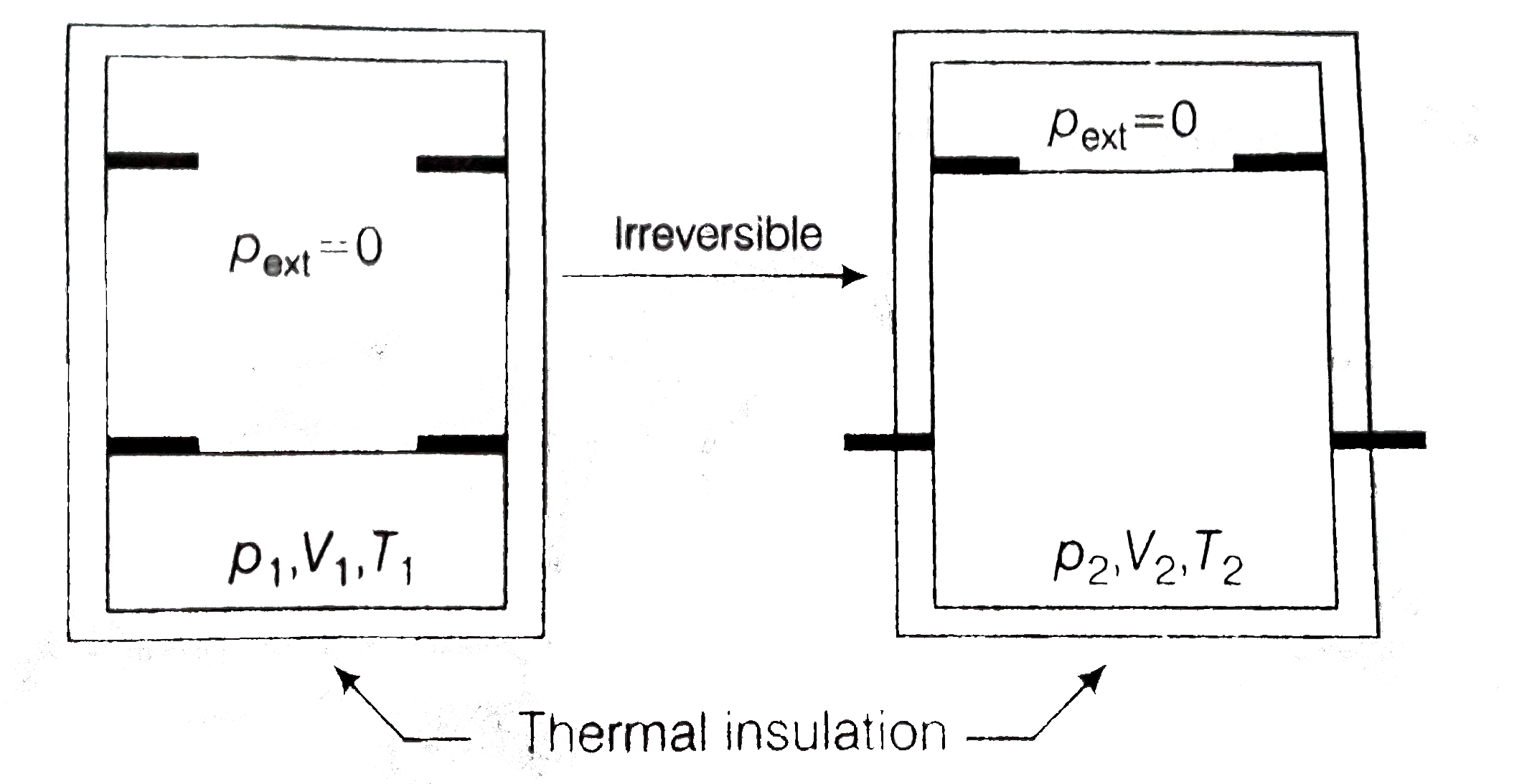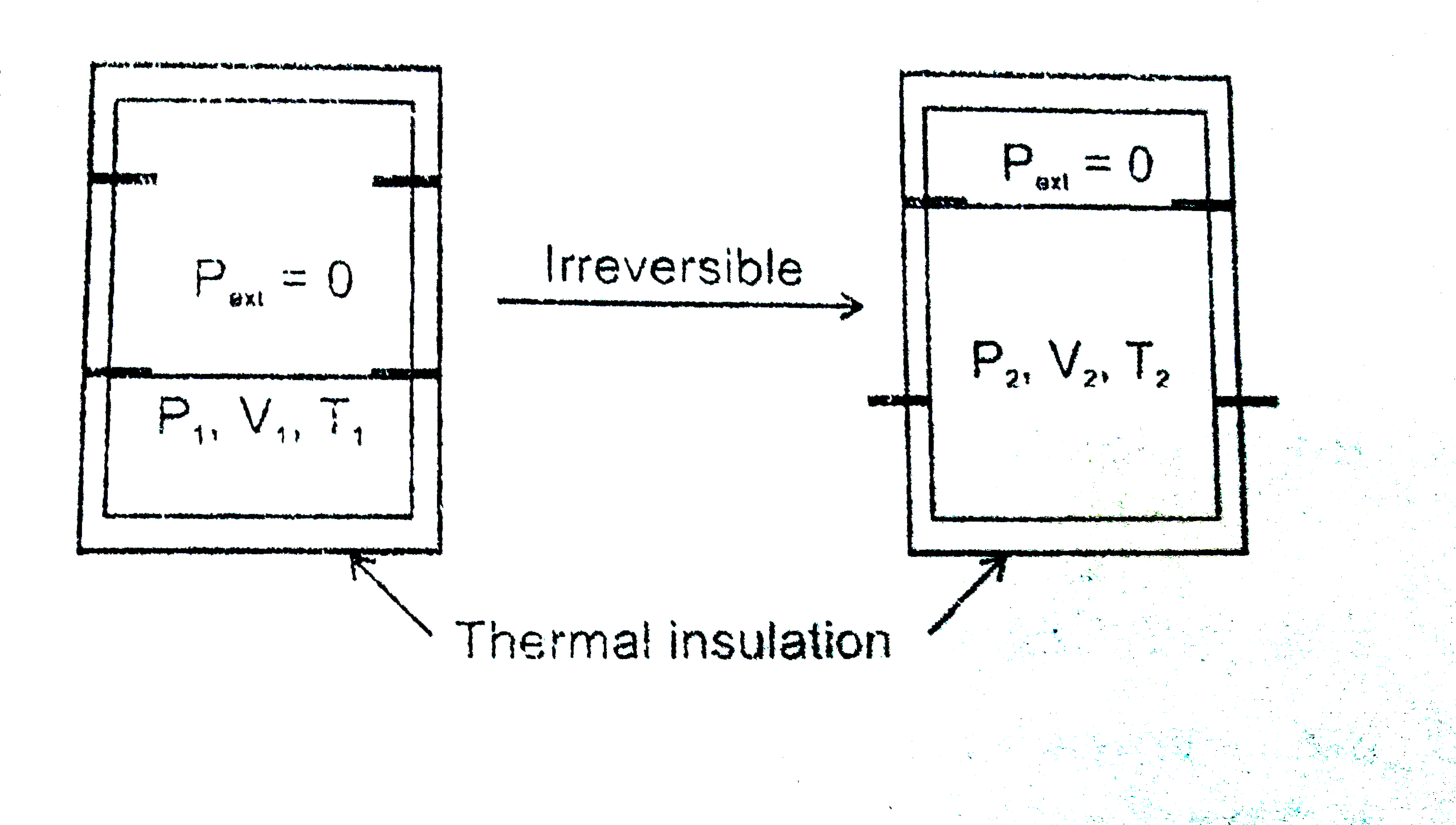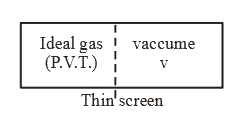An ideal gas in thermally insulated vessel at internal (pressure)=P1,(volume)=V1 and absolute temperature=T1 expands irreversiby against zero external, pressure , as shown in the diagram,
The final internal pressure, volume and absolute temperature of the gas are p2,V2andT2, respectively . For this expansion

q=0
T2=T1
P2V2=P1V1
P1Vγ2=P1Vγ1
The correct Answer is:A, B, C
Since, the vessel is thermally insulated hence q=0
Work done (W=0) is zero for free expansion ΔU is also zero for free expansion, so, T1=T2andP1V1=P2V2 (Isothermal process).
Topper's Solved these Questions
- BOOK - OP TANDONCHAPTER - Chemical Thermodynamics and ThermochemistryEXERCISE - Assertion Reason Type Question29videos
Chemical Thermodynamics and Thermochemistry
- BOOK - OP TANDONCHAPTER - Chemical Thermodynamics and ThermochemistryEXERCISE - Assertion Reason Type Question Set-21videos
Chemical Thermodynamics and Thermochemistry
- BOOK - OP TANDONCHAPTER - Chemical Thermodynamics and ThermochemistryEXERCISE - Objective Question Level B56videos
Chemical Thermodynamics and Thermochemistry
- BOOK - OP TANDONCHAPTER - CHEMICAL KINETICSEXERCISE - LINKED COMPRESHENSION TYPE QUESTIONS ( SECTION-VI)4videos
CHEMICAL KINETICS
- BOOK - OP TANDONCHAPTER - CLASSIFICATION AND NOMENCLATURE OF ORGANIC COMPOUNDS EXERCISE - INTEGER2videos
CLASSIFICATION AND NOMENCLATURE OF ORGANIC COMPOUNDS
Similar Questions
A gas enclosed in a vessel has pressure P, volume V and absolute temperature T, write the formula for number of molecule N of the gas.
View SolutionTwo gases which are at pressure p1 volume V1 and temperature T1 and pressure p2 volume V2 and temperature T2, respectively are forced into a vessel of volume V at temperature T. Calculate pressure of the mixture.
View Solution
Knowledge Check
- Question 1 - Select One or More
An ideal gas in a thermally insulated vessel at internal pressure =P1, volume =V1 and absolute temperature =T1 expands irreversibly against zero external pressure, as shown in the diagram. The final internal pressure, volume and absolute temperature of the gas are P2,V2 and T2 respectively. For this expansion.
 Aq=0BT2=T1CP2V2=PtV1DP2Vγ2=P1Vγ1
Aq=0BT2=T1CP2V2=PtV1DP2Vγ2=P1Vγ1 - Question 2 - Select One
If P, V and T stand for pressure, volume and absolute temperature of a gas, which of the following will be true for Boyle's Law
AV∝T, when P is constantBV∝1P , when T is constantCPV=RTDPV=nRT - Question 3 - Select One
Two containers of equal volume contain the same gas at pressure P1 and P2 and absolute temperature T1 and T2, respectively. On joining the vessels, the gas reaches a common pressure P and common temperature T. The ratio P/T is equal to
Ap1T2+p2T1T1×T2Bp1T2+p2T1T1+T2C12[p1T2+p2T1T1T2]Dp1T2−p2T1T1×T2]
If ideal gas expand against vaccum, insulated container then what will be final volume, final pressure & final temperature
 View Solution
View SolutionOne mole of an ideal monoatomic gas at temperature T and volume 1 L expands to 2 L against a constant external pressure of one atm under adibatic conditions, then final temperature of gas will be :
View SolutionTwo containers of equal volume contain the same gas at pressure P1 and P2 and absolute temperature T1 and T2, respectively. On joining the vessels, the gas reaches a common pressure P and common temperature T. The ratio P/T is equal to
View SolutionTwo identical vessels contain the same gas at pressure P1 and P2 at absolute temperature T1andT2, respectively. On joining the vessels with a small tube as shown in the figure. The gas reaches a common temperature T and a common pressure P. Determine the ratio P/T
 View Solution
View SolutionOne mole of an ideal monoatomic gas at temperature T and volume 1L expands to 2L against a constant external pressure of one atm under adiabatic conditions, then final temperature of gas will be:
View Solution
